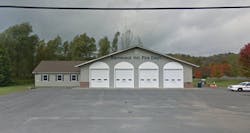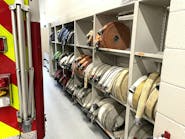New $9.4M OH Fire Station Puts Focus on Health
By Brian Lee
Source Telegram & Gazette, Worcester, Mass.
One final push officially opened the city's newest fire station Wednesday morning.
As part of a tradition, Columbus Division of Fire firefighters and paramedics pushed a fire engine inside the garage bay doors of the new Station 16, located at 1465 Oakland Park Drive, which will provide service to North Linden and the surrounding area.
City Council approved $9.4 million in July 2019 for construction of the station, which replaces the old station on Weber Road that was built in the 1950s.
Battalion Chief Steve Martin said the Weber Road station had been built at a time when Weber Road was on the far north side of Columbus and the city as a whole saw the number of runs that Station 16 now handles by itself.
The new station is equipped to house up to 15 people at a time in single-person dormitory rooms, Martin said. Most shifts have about nine people who would be sleeping at the station, but the station allows for growth or students riding along with fire crews to be housed comfortably.
Like Station 35 opened last year on North Waggoner Road on the Far East Side, Martin said new Station 16 also has a number of features designed to improve and positively impact the health of firefighters and paramedics.
A transition locker room is located immediately off the garage area, allowing firefighters to change out of their uniforms without carrying carcinogens or other materials from fire scenes into the living areas of the station.
Martin said this is important because those combustible materials have been shown to contribute to cancer rates.
"It's like when you go to a campfire and your clothes smell like the campfire," Martin said. "But those things we smell like can involve burning plastic and other things that are hazardous."
The new station also has technology that will help with sleep. Firefighters and paramedics work a 24-hour shift and are often woken up throughout the night for emergency dispatches, even those calls to which only one or two people on the shift would be responding.
"Every time you get woken up, that's an adrenaline dump in your body," Martin said. "Over 30 years of doing it, that has an impact on your cardiac health."
Technology in the station allows the staff to designate which dormitory room belongs to them at the start of each shift and what piece of fire equipment they will be working on: the engine, the rescue truck or the medic ambulance.
Martin said the technology then alerts only the staff needed for each run by sending the emergency dispatches only into those dorm rooms, allowing those not needed to continue to sleep.
The benefits of the health features will not be immediately seen or known, Martin said, but could pay dividends down the road.
"It's not something we'll see results from for maybe 20 years," he said. "But we want health and safety to be a top priority."
___
(c)2021 The Columbus Dispatch (Columbus, Ohio)
Visit The Columbus Dispatch (Columbus, Ohio) at www.dispatch.com
Distributed by Tribune Content Agency, LLC.






